|
Walter Leroy Seiler signed the Davis-Monthan Register twice. He landed first on Saturday September 4, 1926 at 12Noon, probably enjoyed a little lunch, then departed at 2PM. He carried a single passenger identified as "Cadenbach". Based at the Naval Air Station, San Diego, CA, they were eastbound from San Diego to Lordsburg, NM in deHavilland 6391.
In the sharp photograph, below, from site visitor John Underwood, we see Seiler on the left during his employment with the Emsco Aircraft Company, Long Beach, CA [see news clip, below]. Mr. Underwood states, "The other gent is Ted Lundgren. The airplane is an Emsco B-7-C, X-869N, which was the only specimen with a Wright R-540. It crashed at Glendale on 3-22-31 while being demonstrated by Aline Miller. Both she and her companion were killed." Notice the sleek, fabric-covered wheel pants on this airplane, and the Townend speed ring around the engine. Note, too, the well-worn A-1 jacket on Seiler. This could be an artifact of his military flying. Neither Lundgren nor Miller are recorded in the Register. However, Miller was the fiance of Cecil A. Allen and she is discussed on his page.
Walter L. Seiler (L) During Emsco Test Pilot Employ (Source: Underwood)
 |
His second landing was almost a year later on Monday August 8, 1927. He carried "Burus" as passenger. They arrived in Boeing NB-1 6853 (photo of an NB-1 here. His airplane was apparently equipped with floats later in its life). They appeared to be on a round-robin (training?) flight from San Diego to Gila Bend, AZ to Tucson. From the context and annotations in the Register, they may have been part of a five-airplane formation. They all remained overnight in Tucson, departing for San Diego next morning near 8AM. His flights to Tucson were in association with his duty as a US Naval Reserve pilot. He was also based at the Naval Reserve station at Long Beach, CA.
"Seiler, Walter L.
Quartermaster First Class, U.S. Navy
Gunner, French Aviation Unit (Attached), U.S. Naval Aviation Forces
Date Of Action: August 13, 1918
Citation:
The Navy Cross is awarded to Quartermaster First Class Walter L. Seiler, U.S. Navy, for extraordinary heroism and devotion to duty while serving in the French Unit of the U.S. Naval Aviation Service. Quartermaster Seiler took part in an engagement with an enemy submarine on August 13, 1918, off Dunkirk and displayed courage and daring in answering enemy shell fire with a machine gun." |
A few years earlier, Seiler was in the Navy serving in Europe during WWI. At left is his citation for the award of the Navy Cross as a seaplane gunner. This record is found here.
After his military and Navy Reserve tenure, he went to work as chief pilot for Wilmington-Catalina Airlines, Ltd. (W-C; owned by the Wrigley family), which operated the world's shortest air transport route between Wilmington, CA and Catalina Island.
Please follow this link to a history of the W-C line. You will see there a small image of chief pilot Seiler. Interestingly, scroll down to the bottom of the page and you'll see Loening amphibian NC9773. This is the sister ship of NC9772, which landed at Tucson Thursday May 28, 1931. Below, from Popular Aviation (PA) magazine, October, 1931, is an article that provides a description of the new Catalina Island facility for landing and launching the aircraft of Wilmington-Catalina Airlines. The airline started business in June, 1931. The airplane, upper right in the article, appears to be 9772..
Catalina Island/Wilmington-Catalina Airlines, Popular Aviation, October, 1931 (Source: PA)
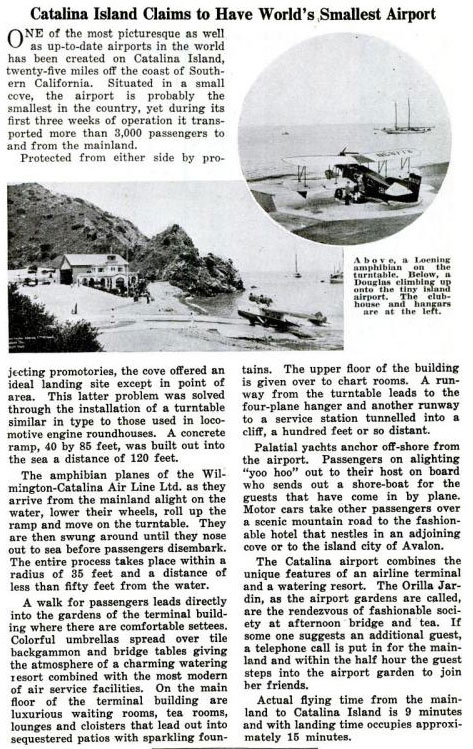 |
Popular Aviation, April, 1941 (Source: PA)
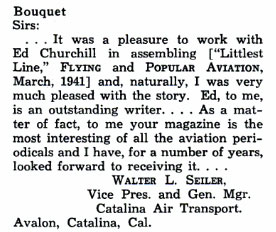 |
Ten years later, in March, 1941, Popular Aviation published a longer article about the airline. You may view the article at the link (PDF 2Mb). The article reports ten year of progress for the airline, which crossed the channel between the mainland and the island 38,000 times, carrying 200,000 passengers over the decade. The article was very positive about the airline, reporting on changes in routes and aircraft. A month later, Seiler wrote a thank you letter that was published in Popular Aviation, right.
Below, from site contibutor Tim Kalina, a photograph of Walter Seiler with two unidentified women. Note the airline livery on the side of the fuselage.
Walter Seiler (C) With Two Unidentified Women, Date Unknown
(Source: Kalina)
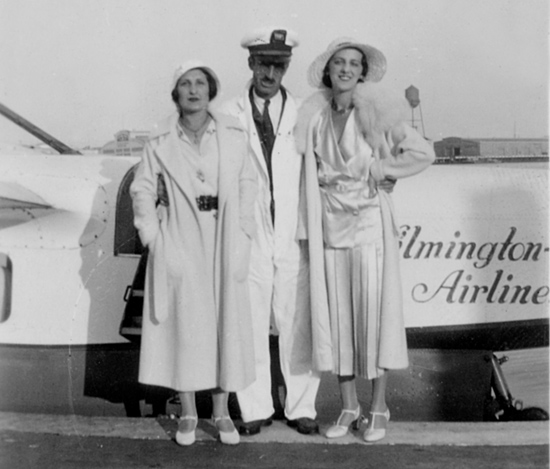 |
Mr. Kalina says about this image, "This is an old vacation photo. It must have been something special to fly out to Catalina as I have seen a number of such photos, many marked 'vacation' or 'first flight'. I assume flying was much more expensive than taking the boat out to Catalina. Wrigley, of course, owned the island, the airline, and the ship line." From the warehouses in the background, this image could have been taken on the mainland side of the route, at Wilmington, CA.
Below, from site Guest Editor Mike Gerow, some anecdotes from his uncle's book as cited. These anecdotes give us insight into Seiler as a person, and as a pilot, and into Wilmington-Catalina Airline as a going concern.
Walter L. Seiler
Chief Pilot, Wilmington-Catalina Airline, Ltd.
Born August 14, 1891 in Ohio; died in Los Angeles County, California on August 13, 1949—the day before his 58th birthday. (Source: Calif. Death Records Since 1940)
The following anecdotes involving Walter L. Seiler are excerpted from (Chapter 5: Catalina Copilot) “The Umpteenth Voyage,” TWA Capt. Gene Gerow’s 1977 memoir of his 42-year aviation career (note: other excerpts from this book can be read at Al Gilhousen and Eddie Bellande.
“…One of the Dolphins had been out of service for extensive maintenance work and relicensing before the rush of summer business. It was in anticipation of that rush that I had been hired, but pending the rescheduling of the second Dolphin I was assigned for my check-out as copilot to fly with the junior first pilot, George Baker, recently from the US Navy. We inherited all of the ‘dog’ flights and made quite a few scenic trips around the southern tip of the island, each lasting about ten minutes. The gear was retracted manually and I found that it took 144 full arm-length strokes of the landing gear pump extension lever to get the gear up or down.
“…After the second Dolphin went back into service I began flying occasionally with other first pilots. P.T.W. Scott was a TWA captain on occasional loan to help out with peak summer schedules…I also flew with Marion Hoblit who had previously checked me out on loops and spins…but the most interesting of all those I flew with was the Chief Pilot, ‘Si’ Seiler.
“He was a genuine character. He was an old ‘sea dog’ and I guess it’s traditional among men in this category to use ‘doggie’ language. Some of his spontaneous utterances in reacting to other people appear quite crusty when recorded but when heard at first hand they were a constant source of amusement to his fellow workers. These remarks were usually slanted at prominent people but once in awhile he would direct a gentle slap at Mr. Common Man (or woman as the case might be).
“There was no door between the cockpit and the passenger cabin and quite often someone would stroll forward during the channel crossing and talk with the crew. On one such occasion a prim looking woman appeared suddenly plucking at the captain’s elbow. Si put on his pilot’s cap and turned around (he always put his flying cap on before he faced anyone). The female passenger said, ‘Captain! This is terrible: we just passed a boat and there was a woman spread out on the deck who was all but naked!’
“Si barked: ‘Hey! We’ll have to make a report on this.’ He wheeled the Dolphin into a vertical bank and got back over the boat and after he had studied the scene below for a couple of circles, he turned to the woman standing between us and said, ‘Yeah, she’s all butt….’
“Quite often we carried well-known movie people and it was a new experience for me to be in such close proximity to name stars; however, Si had been hauling them back and forth for n number of years and would only let his attention be diverted from his flying for short periods at a time. One day Joan Crawford was standing there asking questions and I was valiantly trying to give her the best answers but being a newcomer in the areas, some of them stumped me and I turned to Si for the correct answers.
“Finally Joan asked a question that even Si couldn’t answer but instead of admitting this he pulled his cap down over his eyes and said to me out of the corner of his mouth, ‘Don’t talk to her…she’s drunk.’
“Si and I were gone on an inland charter flight one day and when we came back in later the other copilot, came rushing down to meet us saying, ‘You guys sure missed something today: the President was here, Si! The President of the United States was here today!’
“Si looked at the excited copilot severely and said, ‘What was that S.O.B. snoopin’ around here for?’
“The sea off the island where we landed was fickle and I believe Si’s most repeatable remark came after a bouncy landing among choppy waves created by a nasty ground swell which had moved in since they had left for the mainland. Everyone at the airport thought Si had done a good job of getting the flying boat down there without busting something—maybe a wing-float or a horizontal stabilizer; however, some passengers blame the pilot for every little jolt during the landing regardless of mitigating circumstances. A woman passenger stopped Si after everyone had deplaned and exclaimed: ‘I’ve flown on all of the airlines in the United States and I’ve never experienced a landing as rough as that before!’
“Si pushed his flight cap back on his head and said, ‘Madam, I’ll tell you exactly how it is: the Old Gentleman who controls the wind and the waves doesn’t work for the Wilmington-Catalina Airline.’
“…A few weeks later at my folks Sunshine Acres place near Santa Fe Springs we were listening to a favorite radio station, KFOX at Long Beach, when the program was interrupted by a newsflash: ‘We have just received word from Avalon of the crash into the bay of one of Catalina Airline’s planes. The pilot, Walter Seiler, is in critical condition with multiple injuries, while the copilot, George Baker, and Mr. Moore, manager of the airline, died in the crash.’
“Once again my flying career had received a setback so I went back to Taft and picked up my ‘option’ at the Fire House….
Sayings of Airline Sages
Si Seiler, Chief Pilot of Catalina Airline, when asked by a new copilot hiree what his philosophy in handling air passengers was, said: ‘Treat ‘em rough as hell and tell ‘em nothing.’”
Russ Gerow on the Crash of NC12212
As NC12212’s mechanic during his stay on Catalina, Russ Gerow was intimately familiar with the aircraft and its workings. When asked in 1982 about the crash in which two people lost their lives, he said that the crash of NC12212 was practically guaranteed by the Dolphin’s control-yoke arrangement. Both pilots shared a common wheel which swiveled up and over to either seat by means of a latching knuckle joint about halfway up the column.
Someone in management became interested in the possibility of flying an earlier passenger run through the morning fog to the mainland, instead of waiting for the usual noon burn off. So, under simulated conditions in perfectly clear weather, a test hop was made from the turntable with Seiler under the hood the whole time. Blindly flying her by the seat of his pants, Si found himself in trouble almost immediately. Before the wheel could be unlatched and swung over to the copilot, No. 2 crashed into Avalon Harbor. Si was ejected through the heavy windshield but lived. Killed were copilot George Baker and airline general manager, E. McFarlan Moore. FAA records for NC12212 confirms that this ship was washed out on November 2, 1933 and the registration number cancelled.
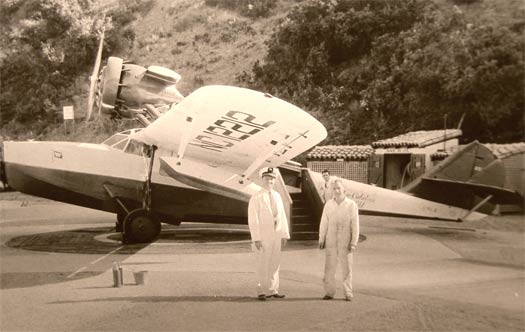 |
Above, Douglas Dolphin No. 2 (NC12212) operated by Catalina Airline. Ex-Continental Air Map employees, pilot P.T.W. Scott (L) and Russ Gerow, mechanic, on the turntable at Avalon. Notice engines are turning over. NC12212 was destroyed in a fatal take-off crash at Avalon, piloted by Walter “Si” Seiler on Nov. 2, 1933. Russ Gerow photo, summer 1932. Russell T. Gerow Collection
Above, Hangar at Avalon, Catalina Island. Note sleeping German Shepherd under starboard wing of NC12212. Loening C-2H Air Yacht (NC9773) in background was P&W Hornet-powered version of sister ship NC9772, a Wright Cyclone-powered C-2C, also operated by Catalina Airline at one point. Russ Gerow photo, summer 1932. Russell T. Gerow Collection
|
New York Times, November 2, 1933
(Source: Gerow)
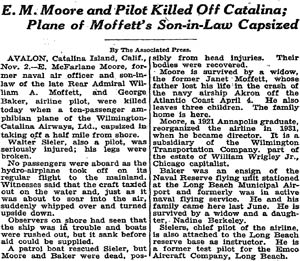 |
At right, from Mike Gerow, a news article from the New York Times of November 2, 1933, which describes the accident that injured Sieler and killed two others. He says of this article, "Although her name is not given in this news item, E. Mac Moore's widow, think her name was Janet, had a very tough year in 1933. Her dad, Adm Moffett was killed 4/4/32 in the Akron and her husband was killed 7 mos. later in NC12212."
An interesting aside is the last paragraph of this article that mentions Seiler's work as test pilot for the Emsco Aircraft Company. See top photo of him, above, when he worked for Emsco. Interestingly, there was only one identified Register entry for an Emsco aircraft, NC849E, flown by Paul T. Adams on August 23, 1933.
Below, two images from Mike Gerow of his father and uncle, and a view of Avalon Harbor in 1932. He says about this first image, "Two well-dressed jailbirds, Russ Gerow, 34, and brother Eugene, 24, during their employment at Avalon, where Russ was a mechanic and Gene a frequent copilot with Wilmington-Catalina Airline’s Chief Pilot Walter L. Seiler. R.T. Gerow Collection, 1932." The "Tia Juana Jail" and "Sloppy Joe's Bar" sets were popular image venues at amusement areas around the country at the time.
Russ Gerow (L) and Eugene Gerow, 1932
(Source: Gerow)
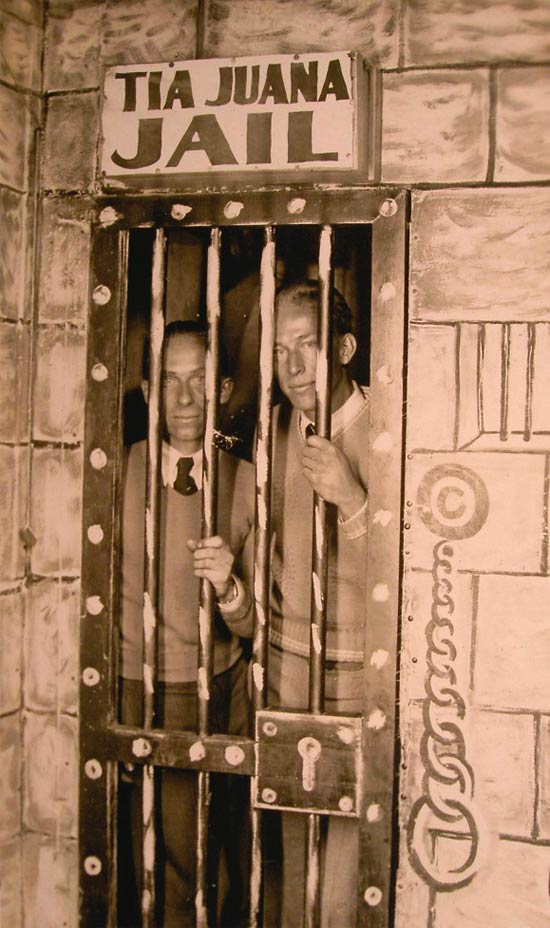 |
Of this second image, below, he says, "Avalon Harbor, Santa Catalina Island. The Wrigley family owned just about everything in this picture, including the 301-foot S.S. Catalina that proudly sailed the channel from 1924-75. S.S. Catalina still exists, a half-submerged hulk in Ensenada, Mexico, awaiting rescue and restoration to her former glory as the “Great White Steamer” of bygone years. According to the Steamship Historical Society, Catalina has carried almost 21 million passengers, more than any other vessel in history. During her WWII service as a troopship in San Francisco Bay, Catalina transported some 821,000 men, more than any other military vessel. The Hamilton Cove seaplane terminal, home of Catalina Airline, was just around the point from the casino at upper right. Russ Gerow photo, summer of 1932. R.T. Gerow Collection." Alas, more recent news from the Los Angeles Times of January 6, 2009 has the S.S. Catalina destined for the scrap heap.
Avalon Harbor, Santa Catalina Island
(Source: Gerow)
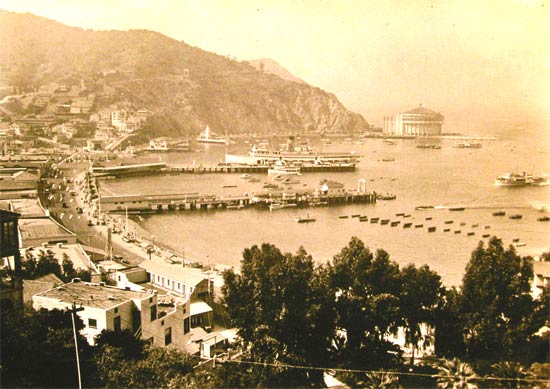 |
Below, again from Mike Gerow, a testimonial signed by Seiler in 1938. This letter to the BG (Sparkplugs) Corporation sings the praises of their product as used in Wilmington-Catalina Airline aircraft. This type of letter was common during the Golden Age. They were used in company advertising. You may see another example of a testimonial letter, in the context of the actual ad (for Waco airplanes), on John Livingston's page, and on this page (ad for Continental Air Lines, Inc.) at the BG Web site.
Walter Seiler 1938 BG Testimonial
(Source: Gerow)
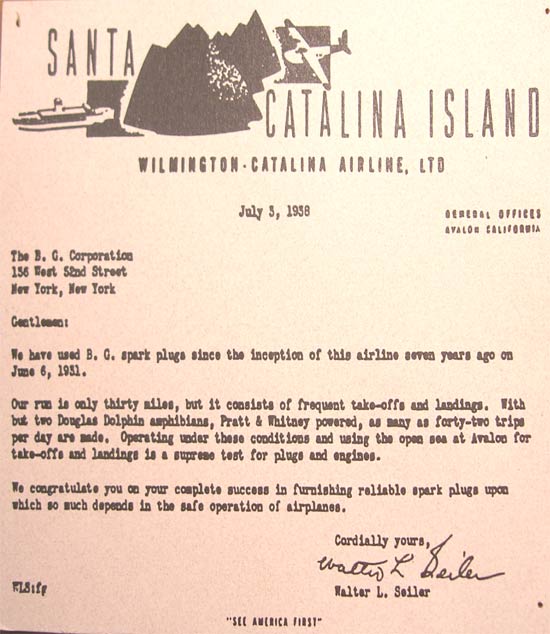 |
Oakland Tribune, January 21, 1936
 |
Contributor Gerow says this image is, "...completely legible considering the original image area is only 5.25" (H) x 4.5" (W). This was on a post card-size format that I found at some swap meet, but it was not a postcard per se; just printed on card stock with a blank reverse side. At the time of the letter, Seiler was Chief Pilot of Wilmington-Catalina Airline, Ltd. Note the old tourism bureau saw at the bottom: 'See America First'."
Further to testimonials, he says, "In studying my dad's old mechanic's notebook while researching [a magazine article] the fairly long list of materials that he was getting together for the big excursion [to Saudi Arabia for oil exploration] included over 1000 feet of various sizes of milled aircraft spruce and other odds 'n' ends. Also included was a line item about being sure to take BG spark plugs--with an exclamation point after the notation. That's a real testimonial that never saw the light of day."
---o0o---
At left, from Mike Gerow, a brief article in the Oakland Tribune that cites Seiler as being a passenger on an amphibian aircraft that was ferried from Los Angeles to Oakland, CA for trans-shipment to Hawaii by boat.
No reason is given for Seiler's presence on this flight. We could conjecture that, given his experience flying amphibians for Wilmington-Catalina Airline, Ltd., he was on-board as an observer. The airplane was a Sikorsky model (factory engineer on-board), so Seiler's presence could have been marketing opportunity for Sikorsky.
This article has little to do with the comings and goings at Tucson recorded in the pages of the Davis-Monthan Register, but I include it as an example of the breadth of activities and influence of just one of our Register pilots. Multiply this by thousands of pilots and passengers and you get some idea of how much real biographical interest and legacy is spawned by our Register.
---o0o---
More about the Wilmington-Catalina Airline, Ltd. operation. The Catalina Island dock for the line is visible during the time the airline was in operation in a couple of the images on this page (see the ones of Douglas Dolphin NC12212. The mainland dock is visible in the image of the US Coast Guard Dolphin, below.
Today, we can get a hint of what the mainland terminal was like at Wilimington from Google Earth. If you direct Google Earth to 33°45'58.59"N by 118°15'38.45"W you will be taken to the location pictured below. If you zoom in you'll see a small rectangular dock just at the southern end of Avalon Boulevard (the dock is near the center of the image below; Avalon Boulevard comes in from the top of the picture).
This is the location of the old Wilmington-Catalina Airlines arrival and departure dock at the Wilmington terminus. Tim Kalina (right sidebar) says of the dock, "... in the film 'Murder on a Honeymoon' the opening scenes show passengers boarding a Dolphin at the small dock. Then there is a great scene, taken from above, of the Dolphin taking-off from the back-channel with lots of warehouses and structures in the background."
If you zoom up and down in Google Earth centered at the dock, you'll be able to see the channel to the south that the Dolphins used for departure and landing. The geometry of the channels, warehouse areas and Terminal Island on the east and Mormon and Smith Islands on the west have probably changed since the 1930s. But the basic gist of the operation can be divined by flexing your imagination and zooming around this area.
Present Location of the Wilmington-Catalina Airlines, Ltd. Mainland Dock
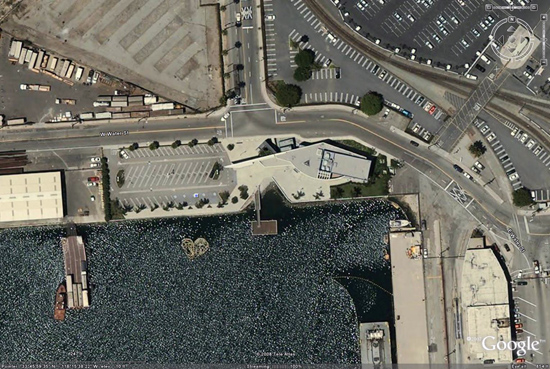 |
Further, from Mike Gerow, we have the three images below of Douglas Dolphins. Neither of the two different airplanes shown are Register craft. The first two images show NC967Y in W-C livery.
W-C Dolphin No. 1, NC967Y, Date Unknown
(Source: Gerow)
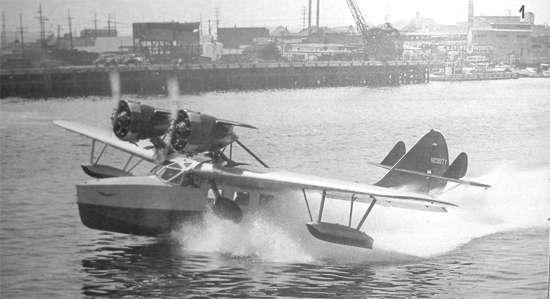 |
Mr. Gerow says this top image shows, "W-C Dolphin No. 1 departing Wilmington dock, possibly in upper right corner of photo." Note the identification numbers in the upper right corners of the three photos.
W-C Dolphin No. 1, NC967Y, Date Unknown
(Source: Gerow)
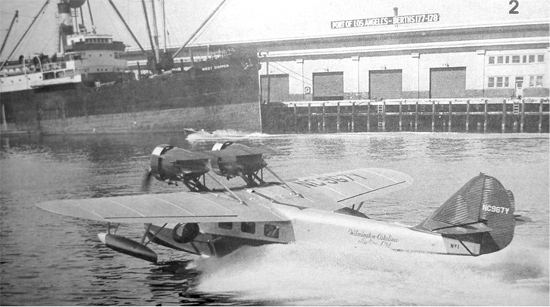 |
Notice the "Port of Los Angeles" signage on top of the warehouse. Mr. Gerow says further, "Comparing the locations of the warehouses in pix 2 and 6, it looks as though the Dolphin in Pic 2 may be taxiing at high speed back to the Wilmington dock after landing in the channel. Pic 6 was taken c. 1941 and shows the dock arrangement to good advantage." Note the ferry Avalon, sister ship of the S.S. Catalina.
U.S.C.G. Dolphin at Wilmington Dock, Ca. 1941
(Source: Gerow)
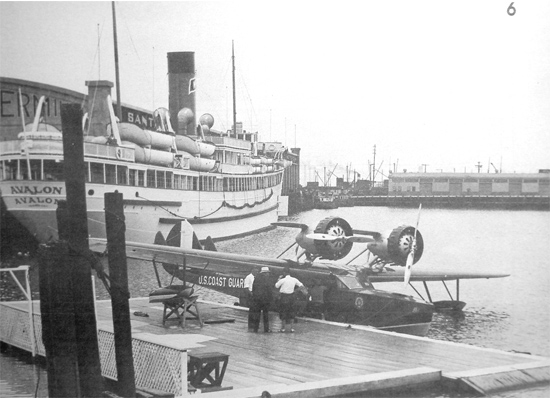 |
Finally, Mr. Gerow says, "These 3 photos are from the Nov 1982 issue of Airpower Magazine that ran an article by Peter M. Bowers, 'The Douglas Dolphin.' These photos appeared on pages 14, 15 and 19, respectively. No photo credits are given." Compare this last photo with the one dated 1924, taken from a different angle, at the Los Angeles Public Library.
---o0o---
Below, two images from Tim Kalina. The first is a beautiful full-color advertisement for the Douglas Dolphin aircraft as used by W-C. The fine print at the bottom of the nighttime image of the airplane over Avalon harbor reads, "A Douglas Amphibion of the Wilmington-Catalina Airline fleet. The line maintains a 10-trip schedule daily between the Southern California mainland and the island." Compare this image with the one of Avalon Harbor exhibited above.
Donor Kalina says about the image, "'Amphibion' is the correct spelling .... it's an antiquated spelling that was peculiar to a few aircraft companies. I have heard that Sikorsky was the first to use this spelling for their amphibious planes. 'First Around the World' refers, of course, to the Douglas World Cruisers. This tagline was used in the Douglas logo for some years and can be seen on DC-2 and early DC-3 tails."
Douglas Dolphin Advertisement
(Source: Kalina)
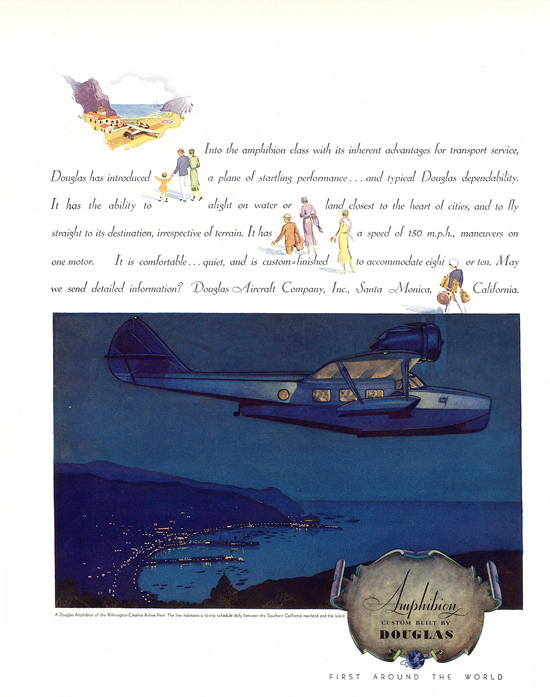 |
Below, a photograph of a W-C Dolphin at the mainland dock. It looks like two or three passengers are getting ready to board while an officer stabilizes the ship by holding onto the pontoon. The registration number of the airplane is unidentified. Compare this image with the Google Earth image, above, to see a top view of this small docking platform.
W-C Dolphin at Mainland Dock, 1938
(Source: Kalina)
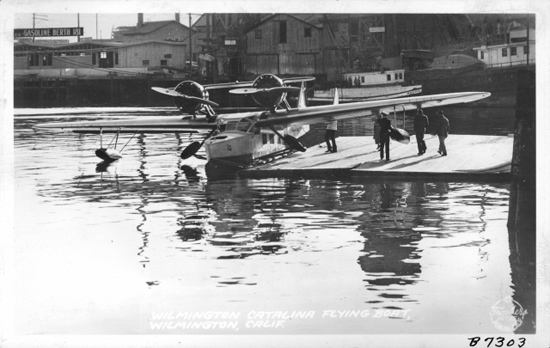 |
Mr. Kalina says this image, "... is a photo postcard from the 'Frasher Foto Collection', which is held by the Pomona Public Library. This collection contains a number of W-C Dolphin photos." The caption printed at the bottom of the photograph reads, "Wilmington Catalina Flying Boat, Wilmington, Calif."
---o0o---
THIS PAGE UPLOADED: 01/01/09 REVISED: 01/10/09, 01/16/09, 01/23/09, 08/07/14
|


















